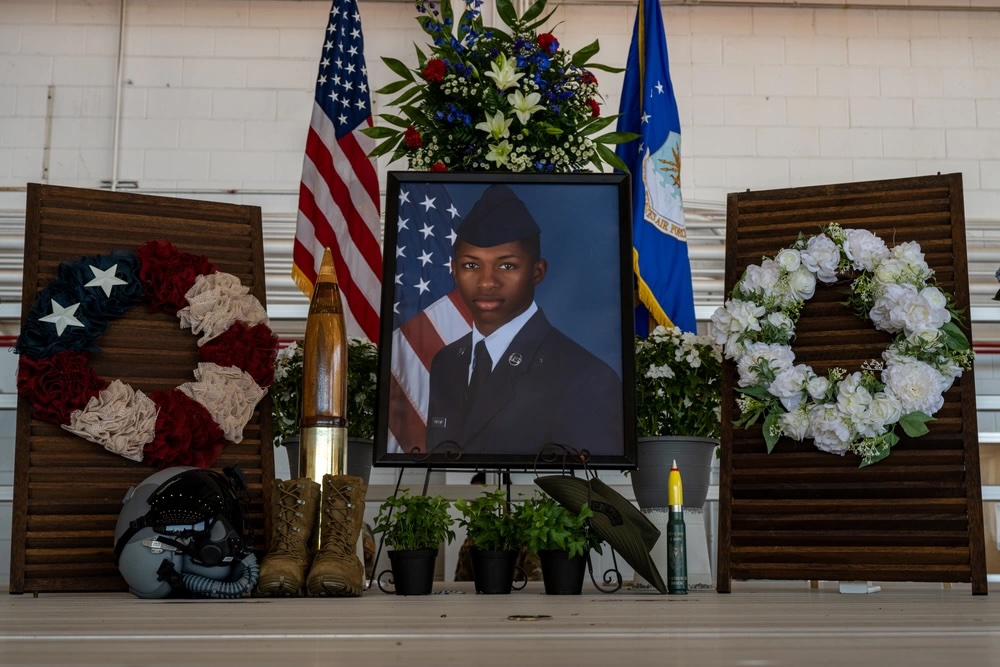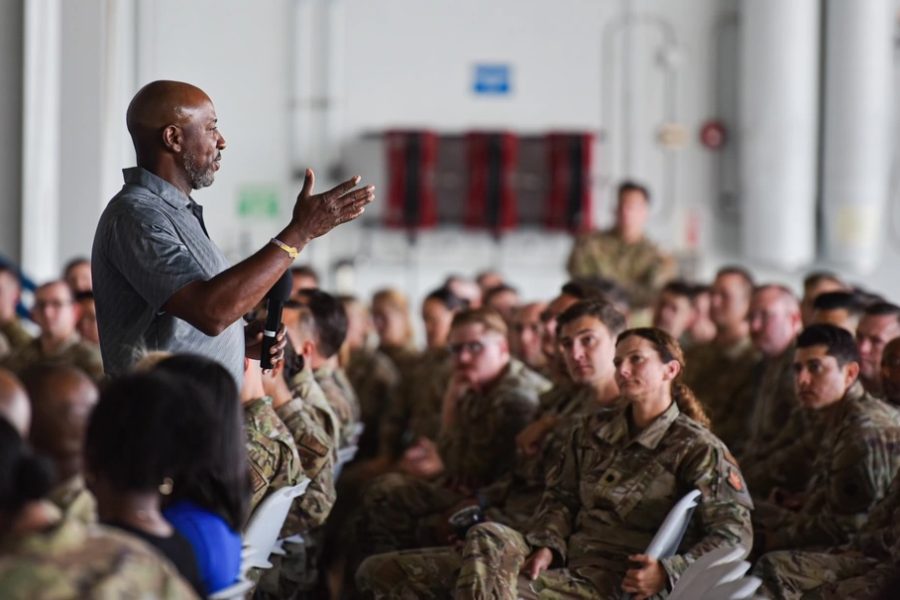As a leadership consultant, retired Chief Master Sergeant of the Air Force Kaleth Wright helps many leaders in and out of uniform hone their craft. When Senior Airman Roger Fortson was killed by a sheriff’s deputy in Florida earlier this month, several Air Force leaders sought his insight on how to handle it.
“They might be wondering if whatever they did was enough, and what would they do differently?” Wright told Air & Space Forces Magazine.
Wright is no stranger to such situations. When George Floyd was killed by police in Minneapolis in 2020 during Wright’s final year as CMSAF, the Airman made headlines by sharing his thoughts about it on Facebook.
“Who am I? I am a Black man who happens to be the Chief Master Sergeant of the Air Force,” he wrote at the time. “What happens all too often in this country to Black men who are subjected to police brutality that ends in death … could happen to me.”
The post also included a warning that became reality earlier this month.
“This, my friends, is my greatest fear, not that I will be killed by a white police officer … but that I will wake up to a report that one of our Black Airmen has died at the hands of a white police officer,” he wrote.
Fortson was killed May 3 by an Okaloosa County Sherriff’s deputy who fired at him while responding to a reported disturbance call at an apartment complex at Fort Walton Beach, Fla. The deputy shot the 23-year-old Fortson six times as the Airman opened his apartment door while holding his legally-owned handgun at his side, pointing downwards. At a May 16 press conference, a lawyer for Fortson’s family, Ben Crump, said the deputy had been called to the wrong apartment.
“This is what I always feared,” Wright wrote on Facebook on May 9. “Praying for his family.”

When Airmen reached out to him for guidance, Wright heard echoes from 2020.
“The theme is the same: ‘I’m not quite sure what to do,’ ‘I’m not quite sure how to feel.’ And people are unsure how to channel their anger,” he said.
Fortson’s death cuts even closer to home for many Airmen.
“They live in apartments, they drive around, they have encounters with policemen, they own firearms,” said Wright, who, like Fortson also lived off-base as a Senior Airman, since on-base dormitories are often limited to the most junior Airmen. “There are just so many similarities that I think cause people to feel like ‘man, this could easily have been me.’”
‘A Huge Message’
In 2020, Floyd’s death helped spark larger discussions about racial disparities in the Air Force, starting with Wright and then-Chief of Staff Gen. David Goldfein. Four years later, the retired CMSAF said he gets the sense that more unit-level Air Force leaders shared their thoughts about Fortson’s death and engaged with Airmen about it sooner, including Fortson’s commander, Col. Patrick Dierig; the head of Air Force Special Operations Command, Lt. Gen. Tony D. Bauernfeind; the top enlisted leader for the 8th Air Force, Chief Master Sgt. Ronnie J. Woods; and current Chief Master Sergeant of the Air Force David A. Flosi.
“I have heard some positives from people saying ‘my leadership is creating space for us to talk and to express our feelings and they’ve been listening,’” Wright said. “And then I’ve also heard kind of the same things I was hearing in 2020: ‘nobody’s saying anything.’”
Events such as Fortson’s death can be tricky to handle for Air Force leaders, most of whom are White. According to 2022 data, the percentage of Air Force colonels, brigadier generals, major generals, lieutenant generals, and generals who are White are 83 percent, 86 percent, 93 percent, 91 percent, and 80 percent, respectively. Those kinds of proportions can limit even the most well-intentioned Airman’s perspective.
“If you’ve never been the only person that looks like you or is of the same gender as you, you don’t know how it feels,” Wright said. “If I’m the only Black person in the unit, I’m not walking around angry all the time. I’m not walking around complaining all the time. I know, in order for my survival, basically, I have to assimilate and I have to pretend like everything is OK. Even if it’s not.”
Two obstacles often make bridging that gap difficult for leaders, Wright noted. The first is not knowing what to say or fear of saying the wrong thing, while the second is a fear of political pushback. As an example, Wright cited Air Force Col. Benjamin Jonsson. Jonsson’s promotion to brigadier general has been delayed 18 months and could stretch into 2025 because of a legislative hold placed by Sen. Eric Schmitt (R-Mo.). Schmitt has said the hold is in opposition to diversity, equity, and inclusion initiatives—Jonsson penned an op-ed addressing racial injustice in 2020.
“That was a huge message to some extent, directly, and to some extent, indirectly, that, ‘hey, if you speak too loudly about this type of stuff, this is what could potentially happen to you and your career,’” Wright said. “It might cause some leaders to say, ‘I’m not quite sure if I want to get involved in this discussion.’”
The discussion is even more delicate considering that Air Force leaders can do little to change wider societal issues like race relations and police brutality. But that does not mean they are powerless, Wright said.
“On this particular issue, young African American males being killed by police officers, I don’t think there’s anything necessarily that the Air Force can or has a responsibility to do,” he said. “However, the Air Force does have a responsibility to continue to create justice and fairness within its own structure when it comes to African American males.”
For example, the Air Force found in its 2020 review of racial disparities that young Black enlisted Airmen and Guardians are almost twice as likely as their White peers to be apprehended by Security Forces and involuntarily discharged based on misconduct. Black Airmen are also underrepresented in operational fields, which promote faster and could contribute to there being fewer high-ranking Black officers.
The federally-funded RAND Corporation also wrote in April that Black male junior enlisted Airmen are 86 percent more likely to be issued an Article 15 or referred to a court-martial than White Airmen. Though the exact causes of those disparities are still unknown, RAND wrote that “having a diverse group of individuals make discipline decisions might mitigate disparities and increase trust in the process,” rather than a lone decision maker.
RAND also called for countermeasures to reduce individual biases that “go beyond traditional training,” with an emphasis “on making changes to the system such that the impacts of individual biases are mitigated.”
Leaning In
Those biases come into sharper focus after an event like Fortson’s death, which gives leaders and Airmen a chance to start a conversation, Wright said. The former CMSAF encouraged leaders to “lean into the issue” and listen to Airmen, even if they may not have all the answers. But listening alone is not enough, Wright said, recalling a recent discussion with a group of Air Force senior leaders who held listening sessions with their Airmen.
“I asked, ‘OK, well, what did you learn?’ And they were pretty quiet,” he said. “There is, I think, a responsibility to allow people to express themselves and listen, but there should be some takeaways: what are you hearing from people that you didn’t already know, that you didn’t realize? Or, what are you hearing that makes you think, ‘OK, based on this feedback that I’m getting from these Airmen, here’s something that we can do differently in our organization.’”
Airmen can also feel empowered to start the conversation. Wright encouraged Airmen to talk with their leadership if they are slow to act.
“Say, ‘hey, here’s the deal, here’s how people in the organization are feeling, and we’d love to have a forum to be able to discuss,'” he said. “You may not be looking for any particular answer, but it doesn’t make sense for us all to walk around and pretend like nothing happened.”
Some troops are already on it: in the weeks since Fortson’s death, Airmen around the world worked together on social media to organize remembrances and tributes for him, many of which took place this week. Those events and conversations can continue into the future.
“Lean on your family, your friends, your colleagues,” Wright said, “and also people who might be able to help you decide, ‘OK, here’s something that we could do in our local area to make this situation better.'”
